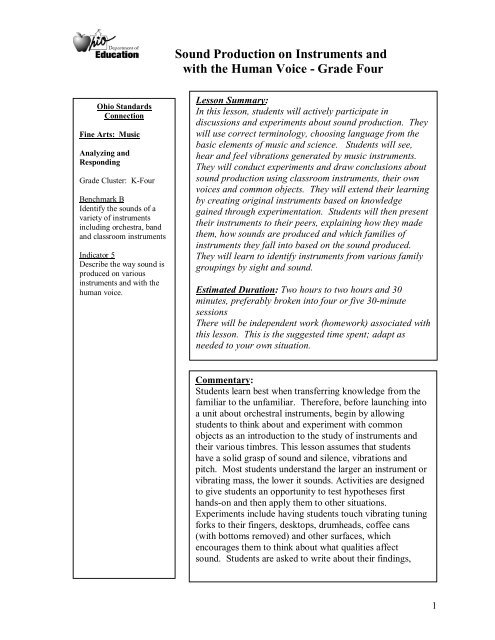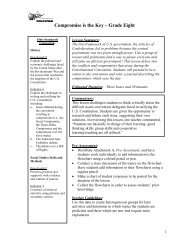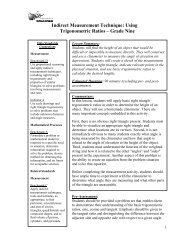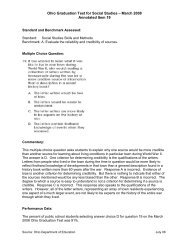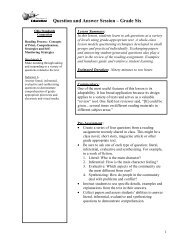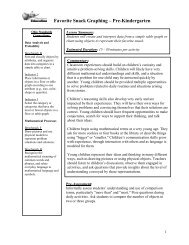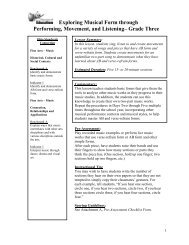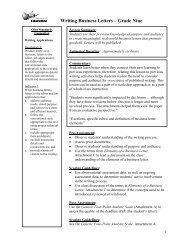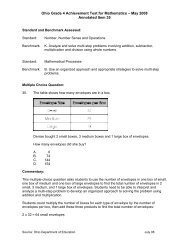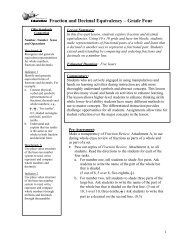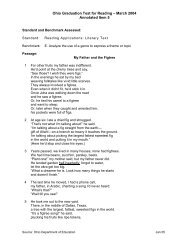Sound Production on Instruments and with the Human Voice - Grade ...
Sound Production on Instruments and with the Human Voice - Grade ...
Sound Production on Instruments and with the Human Voice - Grade ...
You also want an ePaper? Increase the reach of your titles
YUMPU automatically turns print PDFs into web optimized ePapers that Google loves.
<str<strong>on</strong>g>Sound</str<strong>on</strong>g> <str<strong>on</strong>g>Producti<strong>on</strong></str<strong>on</strong>g> <strong>on</strong> <strong>Instruments</strong> <strong>and</strong><strong>with</strong> <strong>the</strong> <strong>Human</strong> <strong>Voice</strong> - <strong>Grade</strong> FourOhio St<strong>and</strong>ardsC<strong>on</strong>necti<strong>on</strong>Fine Arts: MusicAnalyzing <strong>and</strong>Resp<strong>on</strong>ding<strong>Grade</strong> Cluster: K-FourBenchmark BIdentify <strong>the</strong> sounds of avariety of instrumentsincluding orchestra, b<strong>and</strong><strong>and</strong> classroom instrumentsIndicator 5Describe <strong>the</strong> way sound isproduced <strong>on</strong> variousinstruments <strong>and</strong> <strong>with</strong> <strong>the</strong>human voice.Less<strong>on</strong> Summary:In this less<strong>on</strong>, students will actively participate indiscussi<strong>on</strong>s <strong>and</strong> experiments about sound producti<strong>on</strong>. Theywill use correct terminology, choosing language from <strong>the</strong>basic elements of music <strong>and</strong> science. Students will see,hear <strong>and</strong> feel vibrati<strong>on</strong>s generated by music instruments.They will c<strong>on</strong>duct experiments <strong>and</strong> draw c<strong>on</strong>clusi<strong>on</strong>s aboutsound producti<strong>on</strong> using classroom instruments, <strong>the</strong>ir ownvoices <strong>and</strong> comm<strong>on</strong> objects. They will extend <strong>the</strong>ir learningby creating original instruments based <strong>on</strong> knowledgegained through experimentati<strong>on</strong>. Students will <strong>the</strong>n present<strong>the</strong>ir instruments to <strong>the</strong>ir peers, explaining how <strong>the</strong>y made<strong>the</strong>m, how sounds are produced <strong>and</strong> which families ofinstruments <strong>the</strong>y fall into based <strong>on</strong> <strong>the</strong> sound produced.They will learn to identify instruments from various familygroupings by sight <strong>and</strong> sound.Estimated Durati<strong>on</strong>: Two hours to two hours <strong>and</strong> 30minutes, preferably broken into four or five 30-minutesessi<strong>on</strong>sThere will be independent work (homework) associated <strong>with</strong>this less<strong>on</strong>. This is <strong>the</strong> suggested time spent; adapt asneeded to your own situati<strong>on</strong>.Commentary:Students learn best when transferring knowledge from <strong>the</strong>familiar to <strong>the</strong> unfamiliar. Therefore, before launching intoa unit about orchestral instruments, begin by allowingstudents to think about <strong>and</strong> experiment <strong>with</strong> comm<strong>on</strong>objects as an introducti<strong>on</strong> to <strong>the</strong> study of instruments <strong>and</strong><strong>the</strong>ir various timbres. This less<strong>on</strong> assumes that studentshave a solid grasp of sound <strong>and</strong> silence, vibrati<strong>on</strong>s <strong>and</strong>pitch. Most students underst<strong>and</strong> <strong>the</strong> larger an instrument orvibrating mass, <strong>the</strong> lower it sounds. Activities are designedto give students an opportunity to test hypo<strong>the</strong>ses firsth<strong>and</strong>s-<strong>on</strong> <strong>and</strong> <strong>the</strong>n apply <strong>the</strong>m to o<strong>the</strong>r situati<strong>on</strong>s.Experiments include having students touch vibrating tuningforks to <strong>the</strong>ir fingers, desktops, drumheads, coffee cans(<strong>with</strong> bottoms removed) <strong>and</strong> o<strong>the</strong>r surfaces, whichencourages <strong>the</strong>m to think about what qualities affectsound. Students are asked to write about <strong>the</strong>ir findings,Comm1
<str<strong>on</strong>g>Sound</str<strong>on</strong>g> <str<strong>on</strong>g>Producti<strong>on</strong></str<strong>on</strong>g> <strong>on</strong> <strong>Instruments</strong> <strong>and</strong><strong>with</strong> <strong>the</strong> <strong>Human</strong> <strong>Voice</strong> - <strong>Grade</strong> FourCommentary (c<strong>on</strong>tinued):which promotes use of <strong>the</strong> language <strong>and</strong> vocabulary of music <strong>and</strong> <strong>the</strong> science of sound.The homemade instrument assignment requires students to apply <strong>the</strong> less<strong>on</strong>s learned toan individual project.Dedicate <strong>on</strong>e less<strong>on</strong> to an overall introducti<strong>on</strong> <strong>and</strong> pre-assessment. Next, teach soundproducti<strong>on</strong> <strong>on</strong> strings, winds <strong>and</strong> percussi<strong>on</strong> instruments. Intersperse explorati<strong>on</strong> of <strong>the</strong>human voice where appropriate c<strong>on</strong>necti<strong>on</strong>s can be made to o<strong>the</strong>r instruments. This canbe taught in 30-minute periods or addressed individually. Reserve <strong>the</strong> final classsessi<strong>on</strong> for sharing homemade instrument projects by <strong>the</strong> students. Depending <strong>on</strong> <strong>the</strong>number of students in your class, <strong>the</strong> sharing of homemade instruments may require twoclass sessi<strong>on</strong>s.Pre-Assessment:Initiate a discussi<strong>on</strong> <strong>with</strong> students. Sample questi<strong>on</strong>s include:• What is sound? [that which can be heard]• What causes sound? [vibrati<strong>on</strong>s]• How do different objects produce sound? [something vibrates such as strings, airor drum heads]• What causes <strong>the</strong> vibrati<strong>on</strong>s to occur <strong>on</strong> an object or instrument? [One hits <strong>the</strong>m,strums <strong>the</strong>m, taps <strong>the</strong>m, plucks <strong>the</strong>m, scrapes <strong>the</strong>m or blows into <strong>the</strong>m.]• What makes some sounds different from o<strong>the</strong>rs? [size, shape, thickness, material,whe<strong>the</strong>r <strong>the</strong>y are hollow or solid]Lead students to brainstorm orally as many sounds as <strong>the</strong>y can name. Determine whichsounds are musical, <strong>and</strong> which are not. [While music can be defined as sounds that areorganized in time, for purpose of this less<strong>on</strong> we will differentiate between instrument<strong>and</strong> vocal sounds <strong>and</strong> envir<strong>on</strong>mental sounds.]Record <strong>the</strong>ir ideas <strong>on</strong> <strong>the</strong> board.• What do all sounds have in comm<strong>on</strong>? [They can be heard.]• What causes sound? [vibrati<strong>on</strong>s]• What vibrates to produce sound in different instruments? [strings, membranes, vocalcords, air]• What makes some sounds different from o<strong>the</strong>rs? [size, shape, thickness, materials,whe<strong>the</strong>r <strong>the</strong>y are hollow or solid]•2
<str<strong>on</strong>g>Sound</str<strong>on</strong>g> <str<strong>on</strong>g>Producti<strong>on</strong></str<strong>on</strong>g> <strong>on</strong> <strong>Instruments</strong> <strong>and</strong><strong>with</strong> <strong>the</strong> <strong>Human</strong> <strong>Voice</strong> - <strong>Grade</strong> FourObserve students for resp<strong>on</strong>ses. Do <strong>the</strong>y seem to have a solid grasp of <strong>the</strong> basic c<strong>on</strong>cepts ofsound producti<strong>on</strong>? Allow students to make music in some of <strong>the</strong> ways <strong>the</strong>y menti<strong>on</strong>ed byplaying simple patterns <strong>on</strong> rhythm instruments. Since this will be a classroom setting, largegroup, oral, informal pre-assessment will be implemented. Depending <strong>on</strong> <strong>the</strong> resp<strong>on</strong>ses,adjust instructi<strong>on</strong> accordingly.• Distribute Attachment A, Musical <strong>and</strong> Envir<strong>on</strong>mental <str<strong>on</strong>g>Sound</str<strong>on</strong>g>s. Ask students to listsounds heard in <strong>the</strong>ir envir<strong>on</strong>ment. Have <strong>the</strong>m listen quietly for <strong>on</strong>e minute. Then, have<strong>the</strong>m name all <strong>the</strong> sounds <strong>the</strong>y heard. Have <strong>the</strong>m categorize <strong>the</strong> sounds into two lists:musical <strong>and</strong> envir<strong>on</strong>mental.Have each student write a paragraph explaining how musical sound is made, following thisprompt by <strong>the</strong> teacher: “What happens when musical sound occurs? What causes that soundto happen?” These will be assessed based <strong>on</strong> knowledge c<strong>on</strong>tent, <strong>and</strong> not writing skills.Collect <strong>the</strong>se to use as pre-assessment tools. These will <strong>the</strong>n be returned to students al<strong>on</strong>g<strong>with</strong> a copy of <strong>the</strong> pre-assessment guide to use as a reference throughout <strong>the</strong> less<strong>on</strong>.Instructi<strong>on</strong>al Tip:Teachers may choose to assess student underst<strong>and</strong>ing of sound producti<strong>on</strong> informally ra<strong>the</strong>rthan by written paragraphs. Students may address <strong>the</strong> writing prompt as a group, <strong>with</strong> <strong>on</strong>estudent acting as recorder for <strong>the</strong> group.Scoring Guidelines:Use <strong>the</strong> checklist, Pre-Assessment Guide, Underst<strong>and</strong>ing Musical <str<strong>on</strong>g>Sound</str<strong>on</strong>g>, to determine <strong>the</strong>current level of underst<strong>and</strong>ing students have about sound producti<strong>on</strong>, by applying it to <strong>the</strong>paragraph students wrote. Students who include five or more items from <strong>the</strong> checklist in <strong>the</strong>irparagraphs are c<strong>on</strong>sidered proficient. Use <strong>the</strong> results from <strong>the</strong> group scores to guideinstructi<strong>on</strong> <strong>and</strong> remediati<strong>on</strong>. At this level, most students know that sound is <strong>the</strong> result ofvibrati<strong>on</strong>s, but not <strong>the</strong> extent to which physical properties affect sound producti<strong>on</strong>. This willbe a focus of <strong>the</strong> less<strong>on</strong>.Pre-Assessment Guide, Underst<strong>and</strong>ing Musical <str<strong>on</strong>g>Sound</str<strong>on</strong>g>Musical sound is <strong>the</strong> result of vibrati<strong>on</strong>sMusical sound can be high or lowMusical sound can be soft or loudThe length <strong>and</strong> size of an instrument affects its pitchThe presence of a res<strong>on</strong>ator affects <strong>the</strong> sound of an instrumentTightening or loosening of strings, drum heads, lips, or vocal cords affects <strong>the</strong>pitch <strong>and</strong> timbre of a musical soundThe speed of vibrati<strong>on</strong>s affects <strong>the</strong> pitch of a musical soundYes No3
<str<strong>on</strong>g>Sound</str<strong>on</strong>g> <str<strong>on</strong>g>Producti<strong>on</strong></str<strong>on</strong>g> <strong>on</strong> <strong>Instruments</strong> <strong>and</strong><strong>with</strong> <strong>the</strong> <strong>Human</strong> <strong>Voice</strong> - <strong>Grade</strong> FourGeneral Tip:Students or teachers may choose from a variety of activities in which to participate,depending <strong>on</strong> <strong>the</strong> time <strong>and</strong> resources available. Students may be allowed to workindependently, in small groups, or in a large-group setting when carrying out experiments<strong>with</strong> sound. There are many fine collecti<strong>on</strong>s of experiments available through sciencetextbook companies that explore <strong>the</strong> science of sound. See Materials <strong>and</strong> Resources.Colleagues also are good sources for materials. Teachers may create <strong>the</strong>ir own experimentsto address <strong>the</strong> indicator. For example, use a tuning fork to help students see <strong>and</strong> feelvibrati<strong>on</strong>s. Do <strong>the</strong> same <strong>with</strong> traditi<strong>on</strong>al instruments like <strong>the</strong> piano or guitar. Have <strong>the</strong>m strike<strong>the</strong> fork <strong>on</strong> a solid object such as a desk, <strong>the</strong>n touch <strong>the</strong> tines. Then, have <strong>the</strong>m repeat <strong>the</strong>strike <strong>and</strong> place <strong>the</strong> tines in a basin of water. There are many variati<strong>on</strong>s <strong>on</strong> <strong>the</strong>se activities.Be creative!Post-Assessment:Each student will make a homemade instrument to present to <strong>the</strong> class. He or she will berequired to explain how it was made, what materials were used <strong>and</strong> how those choices affect<strong>the</strong> sound of <strong>the</strong> instrument. Students will be required to tell classmates what family ofinstruments (wind, string, percussi<strong>on</strong>) <strong>the</strong> instrument would bel<strong>on</strong>g to, based <strong>on</strong> <strong>the</strong> way itproduces sound. See Attachment B, Homemade Instrument Project Rubric.General Tip:If students c<strong>on</strong>ducted experiments as part of this less<strong>on</strong>, <strong>the</strong> results of <strong>the</strong>ir experiments willbe recorded <strong>and</strong> scored according to <strong>the</strong> rubrics specific to each experiment page. These maybe ready-made or teacher-generated assessments.Instructi<strong>on</strong>al Tips:• If it is unrealistic in your classroom setting to ask students to make instruments outside ofclass, c<strong>on</strong>sider collecting comm<strong>on</strong> materials for <strong>the</strong>m to use. Some fast-food restaurants <strong>and</strong>delis will d<strong>on</strong>ate Styrofoam c<strong>on</strong>tainers <strong>and</strong> cups that can be used to make simple homemadeinstruments.• A letter should be sent home to parents to explain <strong>the</strong> instrument project. In <strong>the</strong> letterinclude Web sites <strong>and</strong> book titles that may be used to help <strong>the</strong> students <strong>with</strong> <strong>the</strong>ir projects.Explain <strong>the</strong> purpose <strong>and</strong> objectives of this less<strong>on</strong> <strong>and</strong> of <strong>the</strong> project itself.Scoring Guidelines:• Ask students to describe <strong>the</strong> way sound is produced <strong>on</strong> various instruments as <strong>the</strong>y make<strong>the</strong>ir individual presentati<strong>on</strong>s to <strong>the</strong> class <strong>and</strong> in class discussi<strong>on</strong>s. They may useclassroom instruments in <strong>the</strong>ir explanati<strong>on</strong>s. Have <strong>the</strong>m dem<strong>on</strong>strate ways of using <strong>the</strong>irvoices <strong>and</strong> explain, using basic terms of music <strong>and</strong> anatomy, how musical sounds areproduced by <strong>the</strong> voice. A rubric will be used for <strong>the</strong> individual instrument projects. SeeAttachment B, Homemade Instrument Project Rubric.4
<str<strong>on</strong>g>Sound</str<strong>on</strong>g> <str<strong>on</strong>g>Producti<strong>on</strong></str<strong>on</strong>g> <strong>on</strong> <strong>Instruments</strong> <strong>and</strong><strong>with</strong> <strong>the</strong> <strong>Human</strong> <strong>Voice</strong> - <strong>Grade</strong> Four• Listen to resp<strong>on</strong>ses of students, both individual <strong>and</strong> in a group, through questi<strong>on</strong> <strong>and</strong>answer exchanges.Students will be assessed by informal discussi<strong>on</strong>, written resp<strong>on</strong>se, <strong>and</strong> extended projects <strong>on</strong><strong>the</strong>ir knowledge of sound producti<strong>on</strong>.Instructi<strong>on</strong>al Procedures:Day One: Introduce <strong>the</strong> less<strong>on</strong>. C<strong>on</strong>duct pre-assessment activities.1. Discuss sound producti<strong>on</strong> <strong>with</strong> students. See pre-assessment.2. Distribute a paper <strong>on</strong> which students classify lists of sounds.3. Have students write paragraphs about sound producti<strong>on</strong>.4. Select a variety of classroom instruments. Include a triangle, res<strong>on</strong>ator bell or cymbal,<strong>and</strong> a h<strong>and</strong> drum. Ask <strong>the</strong> students, “If I play <strong>the</strong>se instruments, will you be able to hear<strong>the</strong> sound <strong>the</strong>y make?” Then, ask <strong>the</strong>m, “When I play <strong>the</strong>se instruments, will you be ableto feel <strong>the</strong> sound <strong>the</strong>y make?” Strike <strong>the</strong> triangle. While it is still ringing, allow studentsto stop <strong>the</strong> sound by placing <strong>the</strong>ir fingers <strong>on</strong> <strong>the</strong> bar, individually. Take turns until manystudents have had a chance to do it. Then, ask <strong>the</strong>m, “What did you feel when you putyour fingers <strong>on</strong> <strong>the</strong> triangle?” Repeat this exercise <strong>with</strong> different instruments <strong>and</strong>students. Lead <strong>the</strong> students to discover that all sound is <strong>the</strong> result of vibrati<strong>on</strong>s. Dosimilar activities <strong>with</strong> h<strong>and</strong> drums of various sizes.5. Review <strong>the</strong> discoveries from today’s less<strong>on</strong>. Review <strong>the</strong> vocabulary used:• <str<strong>on</strong>g>Sound</str<strong>on</strong>g> [The sensati<strong>on</strong> that is perceived by <strong>on</strong>e’s sense of hearing.]• Found sounds/Envir<strong>on</strong>mental sounds [<str<strong>on</strong>g>Sound</str<strong>on</strong>g>s that are present in everyday life suchas a car horn, train, wind.]• Musical [<str<strong>on</strong>g>Sound</str<strong>on</strong>g> that is organized <strong>with</strong>in time, dem<strong>on</strong>strating structure.]• Vibrati<strong>on</strong>s [Rapid rhythmic moti<strong>on</strong> back <strong>and</strong> forth; quiver]Provide students <strong>with</strong> copies of <strong>the</strong> vocabulary words <strong>and</strong> definiti<strong>on</strong>s. These may be posted<strong>on</strong> a “word wall” <strong>and</strong> included in a list that students keep in <strong>the</strong>ir music folders or portfolios.Day Two:6. Review <strong>the</strong> previous less<strong>on</strong>. Resp<strong>on</strong>d to written pre-assessments via class discussi<strong>on</strong>,emphasizing points that directly address <strong>the</strong> identified indicator.• What is sound? [That which can be heard.]• How is sound produced? [by vibrati<strong>on</strong>s]• What things affect sounds? [physical characteristics such as size, shape, material,density]• How many different kinds of sounds can be made <strong>with</strong> <strong>the</strong> human voice? [talking,singing, whispering, shouting, whistling, humming, silly sounds]7. Put children into groups of three, <strong>and</strong> distribute <strong>on</strong>e large, <strong>on</strong>e medium <strong>and</strong> <strong>on</strong>e smallrubber b<strong>and</strong>. Also, give <strong>the</strong>m <strong>on</strong>e coffee can per group. Tell <strong>the</strong>m to keep <strong>the</strong> rubber5
<str<strong>on</strong>g>Sound</str<strong>on</strong>g> <str<strong>on</strong>g>Producti<strong>on</strong></str<strong>on</strong>g> <strong>on</strong> <strong>Instruments</strong> <strong>and</strong><strong>with</strong> <strong>the</strong> <strong>Human</strong> <strong>Voice</strong> - <strong>Grade</strong> Fourb<strong>and</strong>s inside <strong>the</strong> coffee can until fur<strong>the</strong>r instructed. H<strong>and</strong> out Attachment C, RubberB<strong>and</strong> Experiments, <strong>on</strong> which <strong>the</strong> students will record <strong>the</strong>ir findings. Allow about 10minutes to complete <strong>the</strong>se activities. Each student should c<strong>on</strong>tribute, <strong>and</strong> <strong>the</strong>y should taketurns writing answers from <strong>the</strong> group <strong>on</strong> <strong>the</strong> paper.8. Collect papers <strong>and</strong> materials. Ask students to share what <strong>the</strong>y learned. Then, ask <strong>the</strong>m toapply what <strong>the</strong>y learned about sound characteristics of rubber b<strong>and</strong>s to stringedinstruments, including <strong>the</strong> piano. If stringed instruments of any kind are available, letindividual students c<strong>on</strong>duct similar experiments <strong>with</strong> <strong>the</strong>m in fr<strong>on</strong>t of <strong>the</strong> class. Showstudents a picture of <strong>the</strong> workings of <strong>the</strong> human voice, noting <strong>the</strong> different labeled parts.• “How do <strong>the</strong> vocal folds behave like <strong>the</strong> rubber b<strong>and</strong>s?” [They get thinner <strong>and</strong>thicker as <strong>the</strong> voice changes pitch.]• “How do strings <strong>on</strong> a stringed instrument behave like <strong>the</strong> rubber b<strong>and</strong>s?” [Theysound higher when <strong>the</strong>y are pushed down <strong>and</strong> made shorter].9. Lead students to identify <strong>the</strong> group of instruments whose main means of soundproducti<strong>on</strong> occurs <strong>with</strong> strings as <strong>the</strong> “string family.” Have <strong>the</strong>m name as many stringedinstruments as <strong>the</strong>y can list, from <strong>the</strong> orchestra, b<strong>and</strong>, folk, pop <strong>and</strong> ethnic genres. Usepictures <strong>and</strong> real <strong>and</strong> recorded examples to illustrate. See Materials <strong>and</strong> Resources. Did<strong>the</strong>y list <strong>the</strong> human voice as an instrument? If not, include it <strong>and</strong> discuss briefly.10. Ask <strong>the</strong> students to experiment <strong>with</strong> <strong>the</strong>ir voices. Have <strong>the</strong>m speak, hum, <strong>and</strong> sing. Ask<strong>the</strong>m to sing low sounds <strong>and</strong> high sounds. Then, lead <strong>the</strong>m in a questi<strong>on</strong> <strong>and</strong> answerdiscussi<strong>on</strong>.• What do you think happens to your vocal folds when you sing a high pitch?” [Theyget thinner.] Think about <strong>the</strong> rubber b<strong>and</strong>.• What happens when you sing a low pitch? [The vocal folds get thicker.]• How do <strong>the</strong>y feel different? Did it feel like <strong>the</strong>y were thinning or thickening <strong>the</strong>irvocal folds when <strong>the</strong>y changed pitch? How are vocal folds similar to strings <strong>on</strong>instruments? [The vocal folds stretch <strong>and</strong> get thinner <strong>and</strong> tighter to make highersounds, just like strings.]Instructi<strong>on</strong>al Tip:The language thicker <strong>and</strong> thinner to describe <strong>the</strong> changes in <strong>the</strong> vocal folds can be understoodby fourth grade students. Use child-friendly terms to help students underst<strong>and</strong>.11. Let <strong>the</strong> children listen to a recording of people using <strong>the</strong> human voice in unusual ways.Select something like Bobby McFerrin performing, Tibetan m<strong>on</strong>ks chanting (Tuvanthroat singing), African tribal s<strong>on</strong>gs or vocal percussi<strong>on</strong> groups. Discuss <strong>the</strong>ir reacti<strong>on</strong>sto <strong>the</strong> music <strong>the</strong>y heard.12. Show <strong>the</strong> students a stringed instrument. Let <strong>the</strong>m put <strong>the</strong>ir fingers <strong>on</strong> <strong>the</strong> strings <strong>and</strong> <strong>the</strong>res<strong>on</strong>ator to feel <strong>the</strong> vibrati<strong>on</strong>s. Play recordings of stringed instruments <strong>and</strong> showpictures of <strong>the</strong>m.6
<str<strong>on</strong>g>Sound</str<strong>on</strong>g> <str<strong>on</strong>g>Producti<strong>on</strong></str<strong>on</strong>g> <strong>on</strong> <strong>Instruments</strong> <strong>and</strong><strong>with</strong> <strong>the</strong> <strong>Human</strong> <strong>Voice</strong> - <strong>Grade</strong> FourInstructi<strong>on</strong>al Tip:Young students tend to have trouble differentiating between pitch <strong>and</strong> volume. Somestudents think of “higher” as “louder” because of <strong>the</strong> volume c<strong>on</strong>trols <strong>on</strong> electr<strong>on</strong>ic devices.These classroom activities can help <strong>the</strong>m see <strong>and</strong> hear <strong>the</strong> differences <strong>and</strong> underst<strong>and</strong> <strong>the</strong>c<strong>on</strong>cepts that determine pitch. C<strong>on</strong>ducting experiments <strong>with</strong> levels of water in glasses,lengths <strong>and</strong> thickness of rubber b<strong>and</strong>s, etc., can help <strong>the</strong>m underst<strong>and</strong> difficult c<strong>on</strong>cepts suchas how <strong>the</strong> size of res<strong>on</strong>ator or material that is vibrating determines <strong>the</strong> length <strong>and</strong> speed ofvibrati<strong>on</strong>s (frequency) thus affecting <strong>the</strong> pitch of <strong>the</strong> sound. This applies to vocal sounds aswell as instrumental <strong>and</strong> o<strong>the</strong>r sounds.13. Review orally using vocabulary <strong>and</strong> main ideas learned in this less<strong>on</strong> <strong>with</strong> <strong>the</strong> wholegroup. Implement peer review. For example, tell students to explain to each o<strong>the</strong>r how<strong>the</strong> pitch of a rubber b<strong>and</strong> changes as it is stretched. Tell students that <strong>the</strong>y are going tolearn during <strong>the</strong> next music class about ways to make sounds <strong>on</strong> music instruments <strong>with</strong>wind.Day Three14. Review <strong>the</strong> main c<strong>on</strong>cepts learned in <strong>the</strong> previous two less<strong>on</strong>s. Review <strong>the</strong> family ofinstruments that has strings, <strong>and</strong> show several examples, using pictures or realinstruments. Ask a student to explain what he or she learned about strings bydem<strong>on</strong>strating <strong>with</strong> <strong>the</strong> rubber b<strong>and</strong>s <strong>and</strong> coffee can. [The coffee can made <strong>the</strong> soundricher <strong>and</strong> louder.] Also, dem<strong>on</strong>strate <strong>the</strong> effects of a res<strong>on</strong>ator <strong>on</strong> a guitar, violin oro<strong>the</strong>r instrument.15. Ask students to figure out how <strong>on</strong>e would make sound <strong>on</strong> a collecti<strong>on</strong> of items placed <strong>on</strong>a table in <strong>the</strong> fr<strong>on</strong>t of <strong>the</strong> classroom using air. Include some of <strong>the</strong> following: severalpen or marker tops of various sizes, several soda bottles of various sizes, a funnel, alength of copper or plastic plumbing pipe. Let students come to <strong>the</strong> fr<strong>on</strong>t of <strong>the</strong>classroom <strong>and</strong> pick up objects, explaining or dem<strong>on</strong>strating to <strong>the</strong> class <strong>the</strong>ir predicti<strong>on</strong>sof how <strong>the</strong>y will sound when blown into or through. Ei<strong>the</strong>r <strong>the</strong> student or <strong>the</strong> teacher can<strong>the</strong>n test those predicti<strong>on</strong>s by blowing across <strong>the</strong> tops of <strong>the</strong> pipes, bottles, or markers.Ask <strong>the</strong> students questi<strong>on</strong>s:• How does <strong>the</strong> size of <strong>the</strong> object affect <strong>the</strong> sound’s pitch? [The larger <strong>the</strong> object, <strong>the</strong>lower <strong>the</strong> pitch.]• If <strong>the</strong> space in <strong>the</strong> vibrating object is large, will <strong>the</strong> frequency [number of vibrati<strong>on</strong>sper unit of time] be faster or slower? [slower]• What does this teach us about how frequency affects pitch? [The faster <strong>the</strong>frequency, <strong>the</strong> higher <strong>the</strong> pitch.]• What instruments can you name that make <strong>the</strong>ir sound by blowing air through acolumn? [flute, piccolo, recorder, penny whistle, etc.]7
<str<strong>on</strong>g>Sound</str<strong>on</strong>g> <str<strong>on</strong>g>Producti<strong>on</strong></str<strong>on</strong>g> <strong>on</strong> <strong>Instruments</strong> <strong>and</strong><strong>with</strong> <strong>the</strong> <strong>Human</strong> <strong>Voice</strong> - <strong>Grade</strong> Four16. Show <strong>the</strong> students a trumpet mouthpiece. Ask <strong>the</strong>m to tell you how it is played. Moststudents will say <strong>on</strong>e must blow into it. Dem<strong>on</strong>strate blowing into it <strong>with</strong>out buzzingyour lips. Ask students “What is wr<strong>on</strong>g?”; Why didn’t it make any sound?” Experiment<strong>with</strong> resp<strong>on</strong>ses, until some<strong>on</strong>e figures out <strong>the</strong> buzzing acti<strong>on</strong>. Tell students that brassinstruments require three main parts: a mouthpiece, tubing, <strong>and</strong> a bell to produce sound.Take out a short piece of garden hose, three or four feet in length. Place <strong>the</strong> mouthpiecein <strong>on</strong>e end <strong>and</strong> buzz lips. Ask <strong>the</strong> students, “How did <strong>the</strong> sound change?” [It was lowerin pitch.] “Why?” [Because <strong>the</strong> tubing made <strong>the</strong> column l<strong>on</strong>ger.] Next, add a funnel to<strong>the</strong> opposite end of <strong>the</strong> hose from <strong>the</strong> mouthpiece. Again, buzz lips in <strong>the</strong> mouthpiece.Ask <strong>the</strong> students, “How did <strong>the</strong> sound change?” [It got louder.]”Why did that happen?”[Because <strong>the</strong> funnel projected <strong>the</strong> sound coming from <strong>the</strong> tube, like a megaph<strong>on</strong>e does.]If you are comfortable doing so, play a few simple s<strong>on</strong>gs <strong>on</strong> <strong>the</strong> homemade trumpet.Explain how tightening <strong>and</strong> loosening <strong>the</strong> lips also affects <strong>the</strong> pitch. Use a trumpet,tromb<strong>on</strong>e or any o<strong>the</strong>r brass instrument available to dem<strong>on</strong>strate that <strong>the</strong> more tubing aninstrument has, <strong>the</strong> lower its pitch range will be.17. If your students play recorders, use recorders to reinforce <strong>the</strong> c<strong>on</strong>cepts of this less<strong>on</strong>. Letstudents explore what happens to <strong>the</strong> pitch as <strong>the</strong>y cover <strong>the</strong> holes <strong>with</strong> <strong>the</strong>ir fingers.18. Dem<strong>on</strong>strate playing a wind instrument or use a recording to illustrate <strong>the</strong>timbre of various wind instruments. Live dem<strong>on</strong>strati<strong>on</strong>s show students more clearly how<strong>the</strong> instrument works. Invite older b<strong>and</strong> students to dem<strong>on</strong>strate for <strong>the</strong> students. Thiscan also be a good recruiting tool for <strong>the</strong> b<strong>and</strong> program19. Review <strong>the</strong> less<strong>on</strong>s learned in this sessi<strong>on</strong>. Review vocabulary used (See vocabularylist) <strong>and</strong> add new terms to <strong>the</strong> lists in <strong>the</strong>ir folders. Ask students to draw c<strong>on</strong>clusi<strong>on</strong>sabout sound producti<strong>on</strong> relating to pitch, volume <strong>and</strong> timbre. Use informal observati<strong>on</strong>to assess student underst<strong>and</strong>ing.Differentiated Instructi<strong>on</strong>al Support:Instructi<strong>on</strong> is differentiated according to learner needs, to help all learners ei<strong>the</strong>r meet <strong>the</strong>intent of <strong>the</strong> specified indicator(s) or, if <strong>the</strong> indicator is already met, to advance bey<strong>on</strong>d <strong>the</strong>specified indicator(s).• Students who have difficulty <strong>with</strong> <strong>the</strong> writing parts of this less<strong>on</strong> can have o<strong>the</strong>r studentsor people scribe for <strong>the</strong>m, or <strong>the</strong>y can record <strong>the</strong>ir resp<strong>on</strong>ses <strong>on</strong> a tape recorder.• Use a multisensory approach when teaching this less<strong>on</strong>. The nature of <strong>the</strong> activities lendsitself well to many types of learning styles <strong>and</strong> limitati<strong>on</strong>s because it c<strong>on</strong>tains auditory,tactile <strong>and</strong> visual comp<strong>on</strong>ents such as listening to pitches change as levels of water in abottle change, touching a vibrating triangle or seeing <strong>the</strong> ripples in a basin of water whena vibrating tuning fork is submerged in it. This less<strong>on</strong> is designed so that different8
<str<strong>on</strong>g>Sound</str<strong>on</strong>g> <str<strong>on</strong>g>Producti<strong>on</strong></str<strong>on</strong>g> <strong>on</strong> <strong>Instruments</strong> <strong>and</strong><strong>with</strong> <strong>the</strong> <strong>Human</strong> <strong>Voice</strong> - <strong>Grade</strong> Foursegments of <strong>the</strong> less<strong>on</strong> can be experienced by all learners. The goal is to help all studentsmake <strong>the</strong> necessary c<strong>on</strong>necti<strong>on</strong>s required in <strong>the</strong> indicator.• Written or oral resp<strong>on</strong>ses to pointed questi<strong>on</strong>s relating to <strong>the</strong> indicator can be used forassessment. The product (<strong>the</strong> homemade instrument) will be graded according to arubric, <strong>with</strong> c<strong>on</strong>siderati<strong>on</strong> given to <strong>the</strong> ability of each student.• Students who quickly grasp c<strong>on</strong>cepts of selected indicators can extend <strong>the</strong>ir learning byhelping o<strong>the</strong>r students at learning centers.• Students may draw pictures that dem<strong>on</strong>strate what <strong>the</strong>y have learned.Extensi<strong>on</strong>s:• Students who quickly grasp c<strong>on</strong>cepts of selected indicators could develop unique sets ofexperiments for <strong>the</strong> class to use.• Students could make homemade instruments <strong>and</strong> learn to play short melodies <strong>on</strong> <strong>the</strong>m for<strong>the</strong> class. An original melody would be even better!• Have students illustrate sound producti<strong>on</strong> in drawings <strong>with</strong> text ballo<strong>on</strong>s todescribe/explain <strong>the</strong> images.• Put <strong>the</strong> students’ instrument projects in a showcase to share <strong>with</strong> o<strong>the</strong>r students. Have <strong>the</strong>students help <strong>with</strong> placement, labels <strong>and</strong> decorati<strong>on</strong>s for <strong>the</strong> display.• Invite children who play instruments to come into <strong>the</strong> classroom <strong>and</strong> dem<strong>on</strong>strate soundproducti<strong>on</strong> to <strong>the</strong> class.• Ask students to invent new instruments <strong>on</strong> paper, perhaps those that can produce musicalsound in a variety of ways. Have <strong>the</strong>m explain <strong>the</strong>ir c<strong>on</strong>cepts. Then post <strong>the</strong>ir creati<strong>on</strong>s<strong>on</strong> a bulletin board in <strong>the</strong> classroom.• Instruct students to c<strong>on</strong>duct science of sound experiments in <strong>the</strong>ir science class if it isn’tpossible to do <strong>the</strong>m in music class. Work <strong>with</strong> <strong>the</strong> science teacher <strong>on</strong> this!• Have students c<strong>on</strong>duct research about sound producti<strong>on</strong> <strong>and</strong> instruments, <strong>and</strong> writereports. These could be published in a school newspaper or <strong>on</strong> <strong>the</strong> school Web site. Itmight also be c<strong>on</strong>nected to students’ language arts class where such a report can beincluded as a part of <strong>the</strong> student’s general class work.• Have students to create short sound pieces, using as many different vocal sounds aspossible. Have <strong>the</strong>m perform <strong>the</strong>m for <strong>the</strong> rest of <strong>the</strong> class.• Have students create accompaniments to a known s<strong>on</strong>gs or s<strong>on</strong>gs of <strong>the</strong>ir own creati<strong>on</strong>using <strong>the</strong>ir homemade instruments. It might even be a s<strong>on</strong>g about sound!Home C<strong>on</strong>necti<strong>on</strong>s:• Instruct students to explore instruments from around <strong>the</strong> world via <strong>the</strong> Internet, <strong>and</strong>decide how <strong>the</strong>ir sounds are produced from what <strong>the</strong>y learn about <strong>the</strong>m. They may makelists of what <strong>the</strong>y find, <strong>and</strong> categorize <strong>the</strong>m by <strong>the</strong> way <strong>the</strong>ir sounds are produced.• Involve students’ families in <strong>the</strong> homemade instrument project. They also can list sounds<strong>the</strong>y hear at home <strong>and</strong> compare <strong>the</strong> list to <strong>the</strong> <strong>on</strong>es <strong>the</strong>y made at school. They also may9
<str<strong>on</strong>g>Sound</str<strong>on</strong>g> <str<strong>on</strong>g>Producti<strong>on</strong></str<strong>on</strong>g> <strong>on</strong> <strong>Instruments</strong> <strong>and</strong><strong>with</strong> <strong>the</strong> <strong>Human</strong> <strong>Voice</strong> - <strong>Grade</strong> Fourmake lists of sounds from o<strong>the</strong>r envir<strong>on</strong>ments <strong>and</strong> transfer <strong>the</strong> knowledge <strong>the</strong>y learnedabout sound producti<strong>on</strong> to <strong>the</strong> new items.Interdisciplinary C<strong>on</strong>necti<strong>on</strong>s:C<strong>on</strong>tent Area: ScienceSt<strong>and</strong>ard: Physical Science –<strong>Grade</strong> TwoBenchmark C: Recognize sources of energy <strong>and</strong> <strong>the</strong>ir uses.Organizer: Forces <strong>and</strong> Moti<strong>on</strong>Indicators: 1. Explore how things make sound (e.g., rubber b<strong>and</strong>s, tuning forks <strong>and</strong>strings).2. Explore <strong>and</strong> describe sounds (e.g., high, low, soft <strong>and</strong> loud) produced byvibrating objects.C<strong>on</strong>tent Area: ScienceSt<strong>and</strong>ard: Physical Science –<strong>Grade</strong> FiveBenchmark F: Describe <strong>the</strong> properties of light <strong>and</strong> sound energy.Organizer: Nature <strong>and</strong> EnergyIndicators: 6. Describe <strong>and</strong> summarize observati<strong>on</strong>s of <strong>the</strong> transmissi<strong>on</strong>, reflecti<strong>on</strong>, <strong>and</strong>absorpti<strong>on</strong> of sound.7. Describe that changing <strong>the</strong> rate of vibrati<strong>on</strong> can vary <strong>the</strong> pitch of a sound.Ano<strong>the</strong>r possible c<strong>on</strong>necti<strong>on</strong> would be that of Scientific Inquiry (K-2) Benchmarks A, B <strong>and</strong>C.Materials <strong>and</strong> Resources:The inclusi<strong>on</strong> of specific resources <strong>and</strong> references to particular musicians, composers orworks of music in any less<strong>on</strong> developed by <strong>the</strong> Ohio Department of Educati<strong>on</strong> should not beinterpreted as an endorsement of <strong>the</strong> particular resource, musician, composer or work ofmusic. The Ohio Department of Educati<strong>on</strong> does not endorse any particular resource,musician, composer or work of music.The Web addresses listed are for a given site’s main page, <strong>the</strong>refore, it may be necessary tosearch <strong>with</strong>in <strong>the</strong> site to find <strong>the</strong> specific informati<strong>on</strong> required for <strong>the</strong> less<strong>on</strong>. Please notethat informati<strong>on</strong> published <strong>on</strong> <strong>the</strong> Internet changes over time <strong>and</strong> <strong>the</strong> links provided may nol<strong>on</strong>ger c<strong>on</strong>tain <strong>the</strong> informati<strong>on</strong> related to a given less<strong>on</strong>. Teachers are advised to preview allsites before using <strong>the</strong>m <strong>with</strong> students.Note: Some Web sites c<strong>on</strong>tain material that is protected by copyright. Teachers shouldensure that any use of material from <strong>the</strong> Web does not infringe up<strong>on</strong> <strong>the</strong> c<strong>on</strong>tent owner’scopyright.10
<str<strong>on</strong>g>Sound</str<strong>on</strong>g> <str<strong>on</strong>g>Producti<strong>on</strong></str<strong>on</strong>g> <strong>on</strong> <strong>Instruments</strong> <strong>and</strong><strong>with</strong> <strong>the</strong> <strong>Human</strong> <strong>Voice</strong> - <strong>Grade</strong> FourFor <strong>the</strong> teacher:For <strong>the</strong> student:chalk board, dry-erase board or chart paper, chalk, marker, variousclassroom instruments such as barred instruments, triangles, bells,tuning forks, rubber b<strong>and</strong>s, coffee cans <strong>with</strong> <strong>on</strong>e end removed, basinsfor water, blocks of wood, stringed instruments, wood blocks, t<strong>on</strong>eblocks, tuned percussi<strong>on</strong> tubes, glasses or bottle for water, brassinstrument mouthpiece, short secti<strong>on</strong> of garden hose, comm<strong>on</strong> funnel,markers <strong>and</strong> pen tops, short pieces of plastic or copper plumbing pipe,a variety of traditi<strong>on</strong>al instruments, if availablerecordings, videotapes <strong>and</strong> games that dem<strong>on</strong>strate a variety ofinstrument sounds such as Andre Previn Orchestra Kit; Meet <strong>the</strong><strong>Instruments</strong>; Young Pers<strong>on</strong>’s Guide to <strong>the</strong> Orchestra, Le<strong>on</strong>ardBernsteinBooks <strong>on</strong> science of sound: Science Experiments With <str<strong>on</strong>g>Sound</str<strong>on</strong>g>, Levine,Shar & Johnst<strong>on</strong>e, Leslie. Sterling Publishing, 2002; Rubber-b<strong>and</strong>Banjos <strong>and</strong> Java Jive Bass, Sabbeth, Alex;Books <strong>on</strong> instrument making: Cardboard Folk <strong>Instruments</strong> to Make<strong>and</strong> Play, Waring, Dennis, Sterling Tamos Publishing, 2002; KidsMake Music, Hart, Avery & Mantell, Paul, Williams<strong>on</strong> Publishing,1993; Music Crafts for Kids, Fiarotta, Noel & Fiarotta, Phyllis,Sterling Publishing, 1993, Musical Instrument Design: PracticalInformati<strong>on</strong> for Instrument Making, Hopkin, Bart, Sarp Press, 1996.set of materials for each group of students, sheet of chart paper foreach group, individual worksheets, paper <strong>and</strong> pencilsThe materials for <strong>the</strong> homemade instruments will come from home.Vocabulary:*Term in <strong>the</strong> Fine Arts Academic C<strong>on</strong>tent St<strong>and</strong>ards Music Glossary.• durati<strong>on</strong>*• dynamics (loud, soft)• envir<strong>on</strong>mental• found sounds• frequency*• pitch (high, low)• music*(-al)• range• res<strong>on</strong>ator* (sound box)• silence*11
<str<strong>on</strong>g>Sound</str<strong>on</strong>g> <str<strong>on</strong>g>Producti<strong>on</strong></str<strong>on</strong>g> <strong>on</strong> <strong>Instruments</strong> <strong>and</strong><strong>with</strong> <strong>the</strong> <strong>Human</strong> <strong>Voice</strong> - <strong>Grade</strong> Four• sound*• timbre• vibrati<strong>on</strong>• vocal foldsVocabulary words may be introduced in a formal manner or as <strong>the</strong>y occur in <strong>the</strong> less<strong>on</strong>.Students may enter <strong>the</strong> words <strong>and</strong> brief definiti<strong>on</strong>s in <strong>the</strong>ir journals or portfolios or foldersfor future reference. It’s also helpful to have <strong>the</strong>m posted around <strong>the</strong> classroom. Languagearts teachers may choose to reinforce use of <strong>the</strong>se words in <strong>the</strong>ir classes.Technology C<strong>on</strong>necti<strong>on</strong>s: (See Materials <strong>and</strong> Resources)• Students can use <strong>the</strong> Internet to explore instruments from around <strong>the</strong> world.• Students can use <strong>the</strong> Internet to research instrument projects.Research C<strong>on</strong>necti<strong>on</strong>s:• Gokhale, Anuradha A. Collaborative Learning Enhances Critical Thinking. Journal ofTechnology Educati<strong>on</strong>, Volume 7, Number 1, Fall 1995.• Marzano, R., Pickering, D., Pollock, J. (2001). Classroom Instructi<strong>on</strong> that Works:Research-based Strategies for Increasing Student Achievement, Alex<strong>and</strong>ria, Virginia:Associati<strong>on</strong> for Supervisi<strong>on</strong> <strong>and</strong> Curriculum Development.General Tip:If you choose to do centers <strong>with</strong> opportunities for experimentati<strong>on</strong>, it would be advisable tohave things set up <strong>and</strong> ready to go before students enter <strong>the</strong> classroom. Do not put more thanfive children in a group, <strong>and</strong> use ei<strong>the</strong>r <strong>the</strong> clock or a timer to indicate when students shouldchange stati<strong>on</strong>s. Also, be prepared for spills, as <strong>the</strong> students will be working <strong>with</strong> glasses,bottles, <strong>and</strong> pitchers of water for some things. This can be hectic but is very effectiveeducati<strong>on</strong>ally. Avoid doing too many rotati<strong>on</strong>s in <strong>on</strong>e 40-minute period because <strong>the</strong>re is notadequate time for students to process <strong>and</strong> record <strong>the</strong>ir findings. It might be best to work <strong>with</strong><strong>the</strong> classroom teacher or science teacher when planning this part of <strong>the</strong> less<strong>on</strong>.Instructi<strong>on</strong>al Tip:An alternative to <strong>the</strong> stati<strong>on</strong>s <strong>and</strong> group work would be to invite individual students to <strong>the</strong>fr<strong>on</strong>t of <strong>the</strong> class to c<strong>on</strong>duct <strong>the</strong> experiments <strong>with</strong> input <strong>and</strong> feedback from <strong>the</strong> rest of <strong>the</strong>class.Attachments:Attachment A, Musical <strong>and</strong> Envir<strong>on</strong>mental <str<strong>on</strong>g>Sound</str<strong>on</strong>g>s12
<str<strong>on</strong>g>Sound</str<strong>on</strong>g> <str<strong>on</strong>g>Producti<strong>on</strong></str<strong>on</strong>g> <strong>on</strong> <strong>Instruments</strong> <strong>and</strong><strong>with</strong> <strong>the</strong> <strong>Human</strong> <strong>Voice</strong> - <strong>Grade</strong> FourAttachment B, Homemade Instrument Project RubricAttachment C, Rubber B<strong>and</strong> Experiments13
<str<strong>on</strong>g>Sound</str<strong>on</strong>g> <str<strong>on</strong>g>Producti<strong>on</strong></str<strong>on</strong>g> <strong>on</strong> <strong>Instruments</strong> <strong>and</strong><strong>with</strong> <strong>the</strong> <strong>Human</strong> <strong>Voice</strong> - <strong>Grade</strong> FourAttachment AMusical And Envir<strong>on</strong>mental <str<strong>on</strong>g>Sound</str<strong>on</strong>g>sName _______________________________Make two lists below. Include sounds produced by <strong>the</strong> singing voice <strong>and</strong> by instruments <strong>on</strong><strong>the</strong> list called “Musical <str<strong>on</strong>g>Sound</str<strong>on</strong>g>s.” List o<strong>the</strong>r sounds you hear under “Envir<strong>on</strong>mental <str<strong>on</strong>g>Sound</str<strong>on</strong>g>s.”Have fun!MUSICAL SOUNDSENVIRONMENTAL SOUNDS14
<str<strong>on</strong>g>Sound</str<strong>on</strong>g> <str<strong>on</strong>g>Producti<strong>on</strong></str<strong>on</strong>g> <strong>on</strong> <strong>Instruments</strong> <strong>and</strong><strong>with</strong> <strong>the</strong> <strong>Human</strong> <strong>Voice</strong> - <strong>Grade</strong> FourAttachment BHomemade Instrument Project RubricName: _______________________________________C<strong>on</strong>structi<strong>on</strong>4 Instrument is wellc<strong>on</strong>structed<strong>and</strong>nicely decorated.3 Instrument reflectssome effort <strong>on</strong>c<strong>on</strong>structi<strong>on</strong> <strong>and</strong>decorati<strong>on</strong>.2 Instrument reflectssome alterati<strong>on</strong> toan existing form to“make” <strong>the</strong>instrument.1 Student’s projectreflects an existingform <strong>with</strong> little orno alterati<strong>on</strong>.InstrumentFamilyStudent can correctlyplace instrument intocategory of string,wind or percussi<strong>on</strong><strong>and</strong> explain why.Student can correctlyplace instrument intocategory, but cannotexplain why <strong>with</strong>outprompts.Student cannotidentify <strong>the</strong> family towhich his or herinstrument bel<strong>on</strong>gs.Student cannotidentify <strong>the</strong> family hisor her instrumentbel<strong>on</strong>gs to even <strong>with</strong>prompts.Presentati<strong>on</strong> <str<strong>on</strong>g>Sound</str<strong>on</strong>g> <str<strong>on</strong>g>Producti<strong>on</strong></str<strong>on</strong>g> TOTALStudent included allcomp<strong>on</strong>ents requiredin presentati<strong>on</strong>. Heor she did so <strong>with</strong>outprompts from <strong>the</strong>teacher.Student includedmost comp<strong>on</strong>entsrequired inpresentati<strong>on</strong> <strong>with</strong>outprompting.Student includessome comp<strong>on</strong>entsrequired inpresentati<strong>on</strong> <strong>with</strong>outprompting.Student has to beprompted to provideany comp<strong>on</strong>entsrequired inpresentati<strong>on</strong>.Student can producemany good-qualitysounds <strong>on</strong> <strong>the</strong> instrument<strong>and</strong> explain how <strong>the</strong>sound is produced.Student is able to producea good-quality sound <strong>on</strong><strong>the</strong> instrument.Student is able to producea sound <strong>on</strong> <strong>the</strong>instrument.Student is unable toproduce a sound <strong>on</strong> <strong>the</strong>instrument.15
<str<strong>on</strong>g>Sound</str<strong>on</strong>g> <str<strong>on</strong>g>Producti<strong>on</strong></str<strong>on</strong>g> <strong>on</strong> <strong>Instruments</strong> <strong>and</strong><strong>with</strong> <strong>the</strong> <strong>Human</strong> <strong>Voice</strong> - <strong>Grade</strong> FourAttachment CRubber B<strong>and</strong> ExperimentsWork <strong>with</strong> two partners of your choice. Take turns doing <strong>the</strong> activities <strong>and</strong> write down <strong>the</strong>results <strong>on</strong> this paper. Have fun!Students’ names: ___________________, ___________________, __________________1. Select <strong>the</strong> thickest rubber b<strong>and</strong>. Tell <strong>on</strong>e partner to hold it by each end, loosely. Pluck <strong>the</strong>rubber b<strong>and</strong>. What kind of sound did you hear?(quiet? loud? low? high?)thick rubber b<strong>and</strong> medium rubber b<strong>and</strong> small rubber b<strong>and</strong>2. Have <strong>the</strong> same partner stretch <strong>the</strong> rubber b<strong>and</strong> so it is thinner. Pluck it again.How was <strong>the</strong> sound different from <strong>the</strong> first sound?3. Ask <strong>the</strong> same partner to stretch <strong>the</strong> rubber b<strong>and</strong> even thinner, being careful notto break it! How did <strong>the</strong> sound change?Switch places <strong>with</strong> <strong>on</strong>e of your partners. Have him or her select <strong>the</strong> medium rubber b<strong>and</strong><strong>and</strong> give it to <strong>the</strong> third partner. Repeat <strong>the</strong> steps above <strong>with</strong> <strong>the</strong> new rubber b<strong>and</strong>. Yourecord <strong>the</strong> answers this time. Finally, let <strong>the</strong> last pers<strong>on</strong> take a turn writing, <strong>and</strong> repeat<strong>the</strong> first three questi<strong>on</strong>s about <strong>the</strong> smallest rubber b<strong>and</strong>. Record your findings <strong>and</strong> discuss<strong>the</strong>m.16
<str<strong>on</strong>g>Sound</str<strong>on</strong>g> <str<strong>on</strong>g>Producti<strong>on</strong></str<strong>on</strong>g> <strong>on</strong> <strong>Instruments</strong> <strong>and</strong><strong>with</strong> <strong>the</strong> <strong>Human</strong> <strong>Voice</strong> - <strong>Grade</strong> Four4. What did you learn about <strong>the</strong> sound of rubber b<strong>and</strong>s? Which <strong>on</strong>es were <strong>the</strong>lowest in pitch? Which were <strong>the</strong> highest? Were you able to get both low <strong>and</strong>high sounds from every rubber b<strong>and</strong>?Next, stretch <strong>on</strong>e of <strong>the</strong> rubber b<strong>and</strong>s across <strong>the</strong> top of an empty coffee can. Experiment<strong>with</strong> <strong>the</strong> sound of <strong>the</strong> rubber b<strong>and</strong>. How does putting it over <strong>the</strong> coffee can change <strong>the</strong>sound?Let every<strong>on</strong>e in <strong>the</strong> group take a turn experimenting. What did you learn?Did you like <strong>the</strong> sound better when <strong>the</strong> rubber b<strong>and</strong> was <strong>on</strong> <strong>the</strong> coffee can? Why or whynot?17


